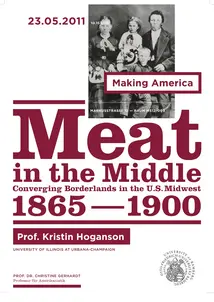Prof. Kristin Hoganson (University of Illinois at Urbana-Champaign): "'Meat in the Middle': Converging Borderlands in the U.S. Midwest, 1865-1900"
23.05.2011, 10:15 Uhr, MS12/00.09
For U.S. historians, the word “borderlands” typically evokes the lands adjacent to the Mexican and Canadian borders. But where do borderlands end? Do they ever stretch so far as to converge? Combining a commodity chain approach with an outward looking local history approach, this talk argues that the Great Lakes and Rio Grande borderlands regions came together in the nineteenth-century U.S. Midwest. Taking cattle production in central Illinois as its case study, it finds that Midwestern farmers positioned themselves along a north-south axis as well as an east-west one. More specifically, it argues that Illinois farmers were embedded in commercial webs that stretched from Ontario to Tamaulipas. From the north, they purchased pedigreed cattle for breeding purposes, and from the south, range animals to fatten. Because of their position on the periphery of each borderlands economy, Midwestern farmers were well positioned to link them together.
Besides broadening the geography of borderlands history, approaching the topic from a point of convergence provides new perspectives on the relational nature of border brokering. Whereas Illinois farmers recognized their many ties with Canada, they tended to overlook their ties to Mexico, centered as they were on commodities rather than interpersonal relationships. In contrast to accounts that domesticated Canada, depicting it as more familial than foreign, farmers’ descriptions of Mexico emphasized the alien and inferior blood to be found there – as evidenced by the mongrel, disease-ridden animals sent to Illinois for fattening. By both revealing and contrasting such transborder relations, this paper sheds light on the ways that northern and southern borders were constituted in relation to each other.
